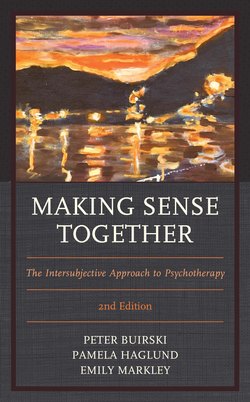Читать книгу Making Sense Together - Peter Buirski - Страница 3
На сайте Литреса книга снята с продажи.
Foreword
ОглавлениеIn my view, the singularly most important development in psychoanalysis (and, by extension, psychotherapy) at the turn of the millennium is its ongoing liberation from the philosophical shackles that Freud inherited from Descartes. The fundamental assumptions of Freudian psychoanalysis were saturated with the Cartesian doctrine of the isolated mind. This doctrine bifurcates the subjective world into outer and inner regions, reifies the resulting separation between the two, and pictures the mind as an objective entity that takes its place among other objects, a “thinking thing” that has an inside with contents and looks out on an external world from which it is radically estranged. Cartesian philosophy, with its myth of the isolated mind, has until recently maintained a stranglehold on psychoanalytical thought.
During the past two decades, a number of viewpoints have appeared that seek, in varying degrees, to emancipate psychoanalytic theory from the grip of Cartesian, isolated-mind thinking. Among such evolving efforts to create a post-Cartesian psychoanalytic theory are Kohutian self psychology, American relational theory, and the intersubjective systems theory developed by my collaborators and me. From our intersubjective perspective, clinical phenomena, such as psychopathological states, transferences, resistances, and negative therapeutic reactions, are grasped not as products of intrapsychic mechanisms originating within the interior of the patient’s isolated mind, but as taking form at the interface of the interacting experiential worlds of patient and therapist. Even the very boundary between conscious and unconscious—the so-called repression barrier—is understood, both developmentally and in the therapeutic situation, not as a fixed intrapsychic structure, but as a fluidly shifting property of an ongoing intersubjective system.
In place of the Freudian unconscious—a sealed-off, underground chamber of the Cartesian isolated mind—we envision a multiply contextualized experiential world, an organized totality of lived personal experience, more or less conscious and more or less contoured according to those organizing principles formed in a lifetime of emotional and relational experience. Instead of a Cartesian container, we picture an experiential system of expectations, interpretive patterns, and meanings, especially those formed in the contexts of psychological trauma. Within such a system or world, one can feel and know certain things, often repetitively, and with unshakable certainty. Whatever one is not able to feel or know falls outside the horizons of a person’s experiential world, requiring no container. One is always organizing one’s emotional and relational experiences so as to exclude whatever feels unacceptable, intolerable, or too dangerous in a particular intersubjective context.
In this view, psychoanalytic therapy is no longer an archaeological excavation of deeper layers of an isolated unconscious mind. Instead, it is a dialogic exploration of a patient’s experiential world, conducted with an awareness of the unavertable contribution of the therapist’s experiential world to the ongoing exploration. Such inquiry seeks comprehension of the principles that prereflectively organize the patient’s world and that keep the patient’s experiencing confined to its limiting horizons. By illuminating such principles in a dialogic context, psychoanalytic therapy aims to expand the patient’s experiential horizons, thereby opening up the possibility of an enriched, more complex, and more flexible emotional life.
In essence, we are recasting psychoanalysis as a contextual psychology, which recognizes the constitutive role of relatedness in the making of all experience. Experiential worlds and intersubjective fields are seen to mutually constitute one another. Unlike Cartesian isolated minds, experiential worlds, as they form and evolve within a nexus of living, relational systems, are recognized as being exquisitely context sensitive and context dependent. The Cartesian bifurcation is mended, and inner and outer are seen to interweave seamlessly.
The dialogic nature of psychoanalytic inquiry is captured beautifully by the title of the present volume, Making Sense Together. Peter Buirski, Pamela Haglund, and Emily Markley have done us all a great service by providing a superb introductory text presenting the basic ideas of intersubjectivity theory in clear, down-to-earth, user-friendly language that will be very accessible and extremely valuable to students and trainees in psychotherapy. The rich clinical illustrations make the intersubjective perspective come alive for the reader. Making Sense Together will be enormous help to therapists in their efforts to explore hitherto uncharted regions of intersubjective space.
—Robert D. Stolorow
Adapted from the article “From Isolated Minds to Experiential Worlds: An Intersubjective Space Odyssey” in the American Journal of Psychotherapy, 54, 149–51, copyright © 2000. Reprinted with permission from the Association for the Advancement of Psychotherapy.
